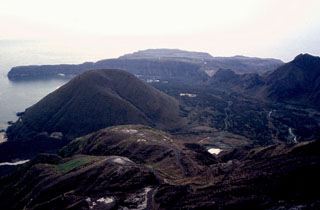Report on Kikai (Japan) — May 2018
Bulletin of the Global Volcanism Network, vol. 43, no. 5 (May 2018)
Managing Editor: Edward Venzke.
Research and preparation by Jackie Gluck.
Kikai (Japan) Elevated thermal activity during February-April 2018; one earthquake swarm in March
Please cite this report as:
Global Volcanism Program, 2018. Report on Kikai (Japan) (Venzke, E., ed.). Bulletin of the Global Volcanism Network, 43:5. Smithsonian Institution. https://doi.org/10.5479/si.GVP.BGVN201805-282060
Kikai
Japan
30.793°N, 130.305°E; summit elev. 704 m
All times are local (unless otherwise noted)
Heightened activity at Kikai (also known as Satsuma Iwojima) was reported during January 2013-July 2014 (BGVN 39:07), which included one eruption with intermittent explosions, occasional ash and steam plumes, and sporadic weak seismic tremor. Subsequently, seismicity remained at background levels, and plume activity was low. A short-lived period of heightened activity occurred in March 2018, with increased daily plume heights, sulfur dioxide output, and seismicity. Activity returned to background levels by 26 April. This report is based on information supplied by the Japanese Meteorological Agency (JMA).
JMA reported that one small-amplitude short-duration volcanic tremor was detected on 16 March 2018. The number of volcanic earthquakes increased on 19 March, with 93 occurrences, prompting JMA to raise the Alert Level from 1 (active volcano) to 2 (restricted area around the crater), on a 5-level scale. The report noted increased thermal activity since February, with occasional visual observations of incandescence. Plume heights and volcanic earthquakes briefly increased during 22-23 March (figure 10, plot 4).
The number of volcanic earthquakes was low during 27 March-2 April. A white plume at the Iwo-dake summit crater rose to 1,800 m above the crater rim in late March (figure 8, plot 4), the highest seen in many years. At the same crater a highly sensitive surveillance camera revealed incandescence at night on 27 and 28 March due to increased thermal activity. No incandescence was observed after 12 April (figure 8, plot 4).
In its report for 20-26 April, JMA noted a white plume at the Iwo-dake summit crater that rose to 700 m above the rim. A field survey conducted on 25 and 26 April confirmed the slight expansion of a thermal anomaly area when compared to 24 and 25 March, but the release amount of sulfur dioxide was slightly less than 300 tons per day (compared with 600 tons on March 24) (figure 8, plot 3).
On 27 April 2018, with volcanic earthquakes being small in number and no observed volcanic tremor, JMA determined that activity had decreased and reduced the warning level from 2 to 1.
Geological Summary. Multiple eruption centers have exhibited recent activity at Kikai, a mostly submerged, 19-km-wide caldera near the northern end of the Ryukyu Islands south of Kyushu. It was the source of one of the world's largest Holocene eruptions about 6,300 years ago when rhyolitic pyroclastic flows traveled across the sea for a total distance of 100 km to southern Kyushu, and ashfall reached the northern Japanese island of Hokkaido. The eruption devastated southern and central Kyushu, which remained uninhabited for several centuries. Post-caldera eruptions formed Iodake (or Iwo-dake) lava dome and Inamuradake scoria cone, as well as submarine lava domes. Recorded eruptions have occurred at or near Satsuma-Iojima (also known as Tokara-Iojima), a small 3 x 6 km island forming part of the NW caldera rim. Showa-Iojima lava dome (also known as Iojima-Shinto), a small island 2 km E of Satsuma-Iojima, was formed during submarine eruptions in 1934 and 1935. Mild-to-moderate explosive eruptions have occurred during the past few decades from Iodake, a rhyolitic lava dome at the eastern end of Satsuma-Iojima.
Information Contacts: Japan Meteorological Agency (JMA), Otemachi, 1-3-4, Chiyoda-ku Tokyo 100-8122, Japan (URL: http://www.jma.go.jp/).


